- Blog
- What Is Experiment Marketing? (With Tips and Examples)
What Is Experiment Marketing? (With Tips and Examples)
-
Nikolett Lorincz
- Marketing
- 6 min read
Table of Contents
Do you feel like your marketing efforts aren’t quite hitting the mark? There’s an approach that could open up a whole new world of growth for your business: marketing experimentation.
This isn’t your typical marketing spiel. It’s about trying new things, seeing what sticks, and learning as you go. Think of it as the marketing world’s lab, where creativity meets strategy in a quest to wow audiences and break the internet.
In this article, we’ll talk about what are marketing experiments, offer some killer tips to implement and analyze marketing experiments, and showcase examples that turned heads.
Ready to dive in?
What is a marketing experiment?
Marketing experimentation is like a scientific journey into how customers respond to your marketing campaigns.
Imagine you’ve got this wild idea for your PPC ads. Instead of just hoping it’ll work, you test it. That’s your experiment. You’re not just throwing stuff at the wall to see what sticks. You’re carefully choosing your shot, aiming, and then checking the impact.
Marketing experiments involve testing lots of things, like new products and how your marketing messages affect people’s actions on your website.
Why should you run marketing experiments?
Running a marketing experiment before implementing new strategies is essential because it serves as a form of insurance for future marketing endeavors.
By conducting marketing experiments, you can assess potential risks and ensure that your efforts align with the desired outcomes you seek.
One of the main advantages of marketing experiments is that they provide insight into your target audience, helping you better understand your customers and optimize your marketing strategies for better results.
By ensuring that your new marketing strategies are the most impactful, you’ll achieve better campaign performance and a better return on investment.
How to design marketing experiments?
Now that we’ve unpacked what are marketing experiments, let’s dive deeper. To design a successful marketing experiment, follow the steps below.
1. Identify campaign objectives
Establishing clear campaign objectives is essential. What do you want to accomplish? What are your most important goals?
To identify campaign objectives, you can:
- Review your organizational goals
- Brainstorm with your team
- Use the SMART framework (Specific, Measurable, Achievable, Relevant, Time-bound) to define your objectives
Setting specific objectives ensures that your marketing experiment is geared towards addressing critical business challenges and promoting growth. This focus will also help you:
- Select the most relevant marketing channels
- Define success metrics
- Create more successful campaigns
- Make better business decisions
2. Make a good hypothesis
Making a hypothesis before conducting marketing experiments is crucial because it provides a clear direction for the experiment and helps in setting specific goals to be achieved.
A hypothesis allows marketers to articulate their assumptions about the expected outcomes of various changes or strategies they plan to implement.
By formulating a hypothesis, marketers can create measurable and testable statements that guide the experiment and provide a basis for making informed decisions based on results.
It helps in understanding what impact certain changes may have on your customers or desired outcomes, thus enabling marketers to design effective experiments that yield valuable insights.
3. Select the right marketing channels
Choosing the right marketing channels is crucial for ensuring that your campaign reaches your customers effectively.
To select the most appropriate channels, you should consider factors such as the demographics, interests, and behaviors of your customers, as well as the characteristics of your product or service.
Additionally, it’s essential to analyze your competitors and broader industry trends to understand which marketing channels are most effective in your niche.
4. Define success metrics
Establishing success metrics is a crucial step in evaluating the effectiveness of your marketing experiments.
Defining success metrics begins with identifying your experiment’s objectives and then choosing relevant metrics that can help you measure your success. You’ll also want to set targets for each metric.
Common success metrics include:
- conversion rate,
- cost per acquisition,
- and customer lifetime value.
When selecting appropriate metrics for measuring the success of your marketing experiments, you should consider the nature of the experiment itself – whether it involves email campaigns, landing pages, blogs, or other platforms.
For example, if the experiment involves testing email subject lines, tracking the open rate would be crucial to understanding how engaging the subject lines are for the audience.
When testing a landing page, metrics such as the submission rate during the testing period can reveal how effective the page is in converting visitors.
On the other hand, if the experiment focuses on blogs, metrics like average time on page can indicate the level of reader engagement.
How to implement marketing experimentation?
Once you’ve finished designing your marketing experiments, it’s time to put them into action.
This involves setting up test groups, running tests, and then monitoring and adjusting the marketing campaigns as needed.
Let’s see the implementation process in more detail!
1. Setting up test groups
Establishing test groups is essential for accurately comparing different marketing strategies. To set up test groups, you need to define your target audience, split them into groups, create various versions of your content, and configure the test environment.
Setting up test groups ensures your marketing experiment takes place under controlled conditions, enabling you to compare results more accurately.
This, in turn, will help you identify the most effective tactics for your audience.
2. Running multiple tests simultaneously
By conducting multiple tests at the same time, you’ll be able to:
- Collect more data and insights
- Foster informed decision-making
- Improve campaign performance
A/B testing tools that allow for simultaneous experiments can be a valuable asset for your marketing team. By leveraging these tools, you can streamline your experiment marketing process and ensure that you’re getting the best results from your efforts.
3. Monitoring and adjusting the campaign
Monitoring and adjusting your marketing experiment campaign is essential to ensure that the experiment stays on track and achieves its objectives.
To do so, you should regularly:
- Review the data from your experiment to identify any issues.
- Make necessary adjustments to keep the experiment on track.
- Evaluate the results of those adjustments.
Proactive monitoring and adjustment of your campaign helps identify potential problems early, enabling you to make decisions based on data and optimize your experiments.
How to analyze your experiment marketing campaign?
As discussed above, after implementing your marketing experiment you’ll want to analyze the results and learn from the insights gained.
Remember that the insights gained from your marketing experiments are not only valuable for the current campaign you’re running but also for informing your future marketing initiatives.
By continuously iterating and improving your marketing efforts based on what you learn from your experiments, you can unlock sustained growth and success for your business.
1. Evaluating the success of your campaign
Assessing the success of your marketing experiment is vital, and essentially it involves determining if the campaign met its objectives and whether the marketing strategies were effective.
To evaluate the success of your marketing campaigns, you can:
- Compare website visits during the campaign period with traffic from a previous period
- Utilize control groups to measure the effect of the campaign
- Analyze data such as conversion rates and engagement levels
2. Identifying patterns and trends
Recognizing patterns and trends in the data from your marketing experiments can provide valuable insights that can be leveraged to optimize future marketing efforts.
Patterns indicate that many different potential customers are experiencing the same reaction to your campaigns, for better or for worse.
To identify these patterns and trends, you can:
- Visualize customer data
- Combine experiments and data sources
- Conduct market research
- Analyze marketing analytics
By identifying patterns and trends in your marketing experiment data, you can uncover insights that will help you refine your marketing strategies and make data-driven decisions for your future marketing endeavors.
3. Applying learnings to future campaigns
Leveraging the insights gained from your marketing experiment in future campaigns ensures that you can continuously improve and grow the effectiveness of your marketing efforts.
Applying learnings from your marketing experiments, quite simply, involves:
- analyzing the data,
- identifying the successful strategies,
- documenting key learnings, and
- applying these insights to future campaigns
By consistently applying the learnings from your marketing experiments to your future digital marketing efforts, you can ensure that your marketing strategies are data-driven, optimized for success, and always improving.
3 real-life examples of experiment marketing
Now that we’ve talked about the advantages of experiment marketing and the steps involved, let’s dive into real-life cases that showcase the impact of this approach.
By exploring these experiment ideas, you’ll get a clear picture of how you can harness experiment marketing to get superior results.
You can take these insights and apply them to your own marketing experiments, boosting your campaign’s performance and your ROI.
Example 1: Homepage headline experiment
Bukvybag, a Swedish fashion brand selling premium bags, was on a mission to find the perfect homepage headline that would resonate with its website visitors.
They tested multiple headlines with OptiMonk’s Dynamic Content feature to discover which headline option would be most successful with their customers and boost conversion rates.
Take a look at the headlines they experimented with, which all focused on different value propositions.
Original: “Versatile bags & accessories”

Variant A: “Stand out from the crowd with our fashion-forward and unique bags”
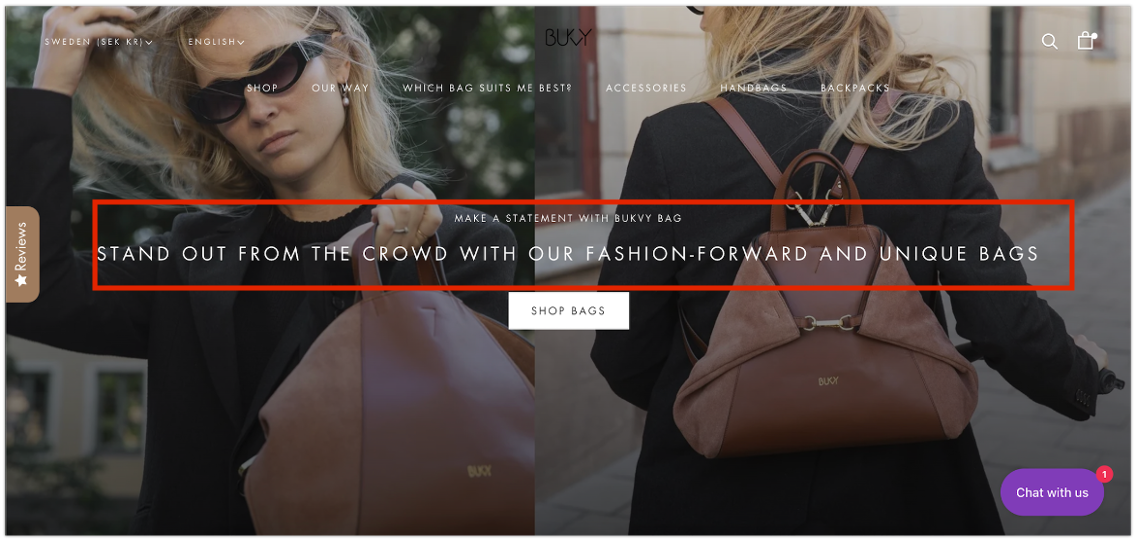
Variant B: “Discover the ultimate travel companion that combines style and functionality”
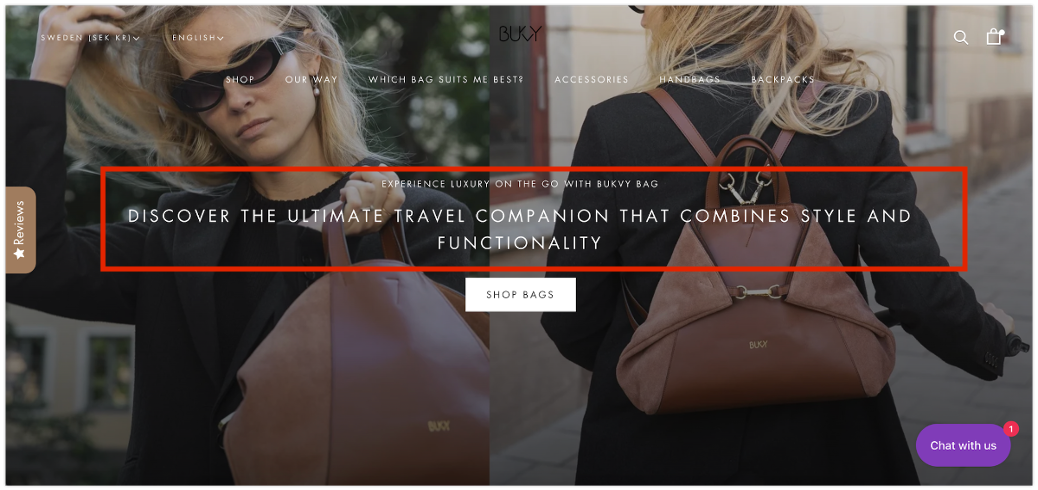
Variant C: “Premium quality bags designed for exploration and adventure”
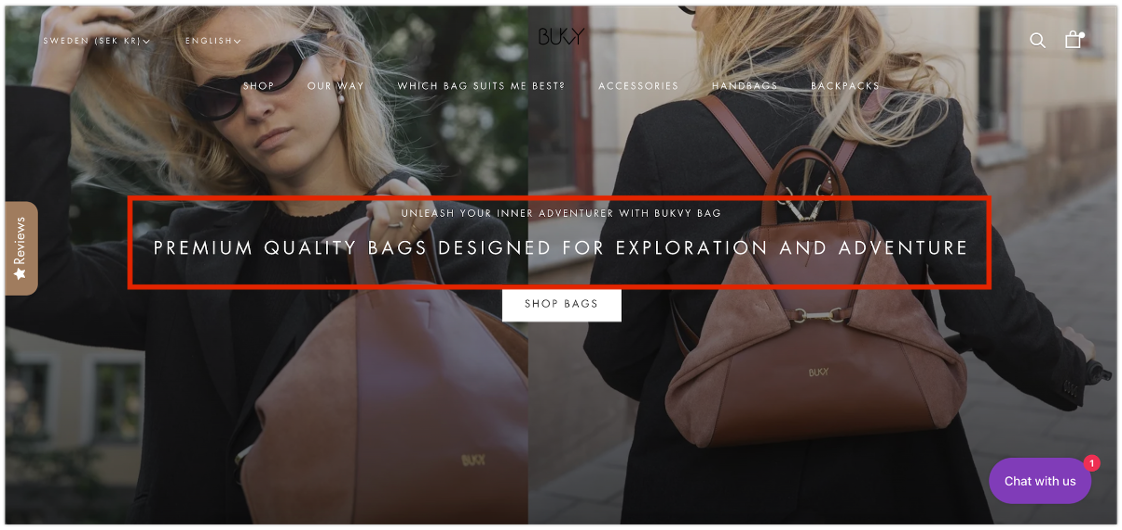
The results? Bukvybag’s conversions shot up by a whopping 45% as a result of this A/B testing!
Example 2: Product page experiment
Varnish & Vine, an ecommerce store selling premium plants, discovered that there was a lot they could do to optimize their product pages.
They turned to OptiMonk’s Smart Product Page Optimizer and used the AI-powered tool to achieve a stunning transformation.
First, the tool analyzed their current product pages. Then, it crafted captivating headlines, subheadlines, and lists of benefits for each product page automatically, which were tailored to their audience.
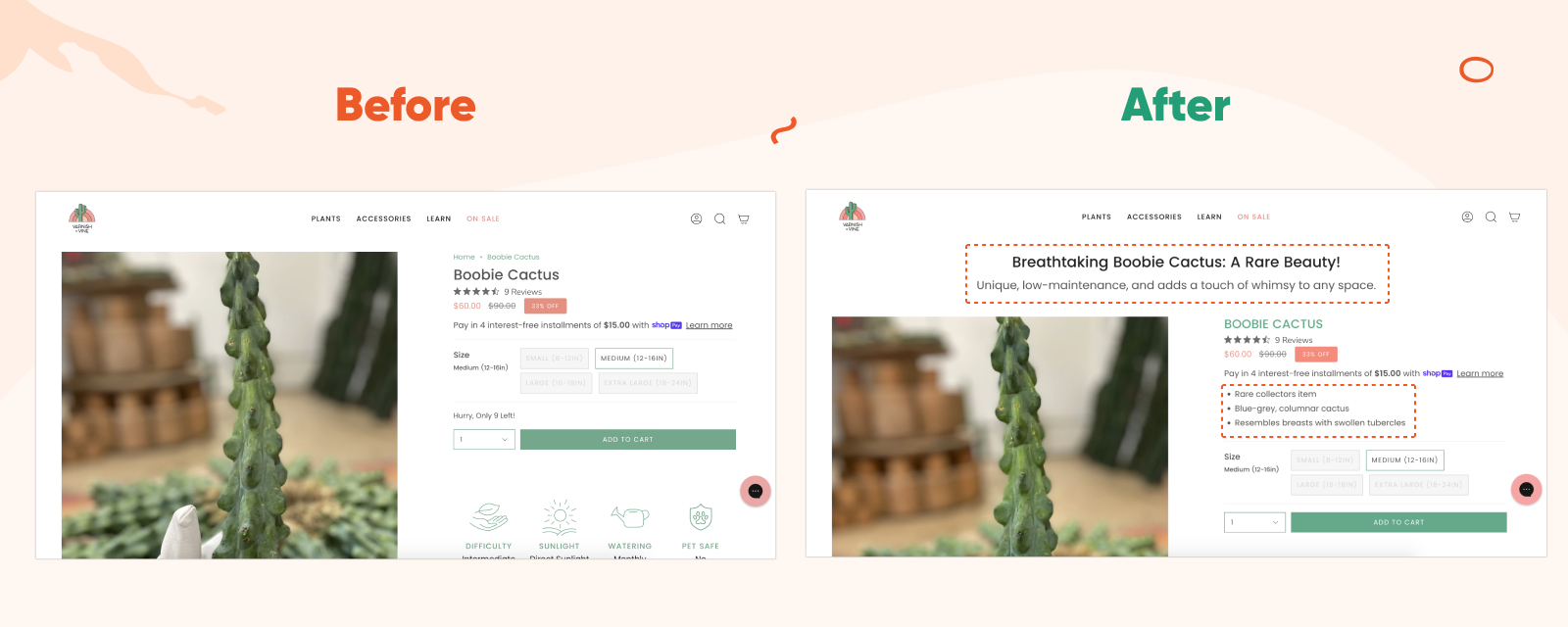
After the changes, the tool ran A/B tests automatically, so the team was able to compare their previous results with their AI-tailored product pages.
The outcome? A 12% boost in orders and a jaw-dropping 43% surge in revenue, all thanks to A/B testing the AI-optimized product pages.
Example 3: Email popup experiment
Crown & Paw, an ecommerce brand selling artistic pet portraits, had been using a simple Klaviyo popup that was underperforming, so they decided to kick it up a notch with a multi-step popup instead.
On the first page, they offered an irresistible discount, and as a plus they promised personalized product recommendations.
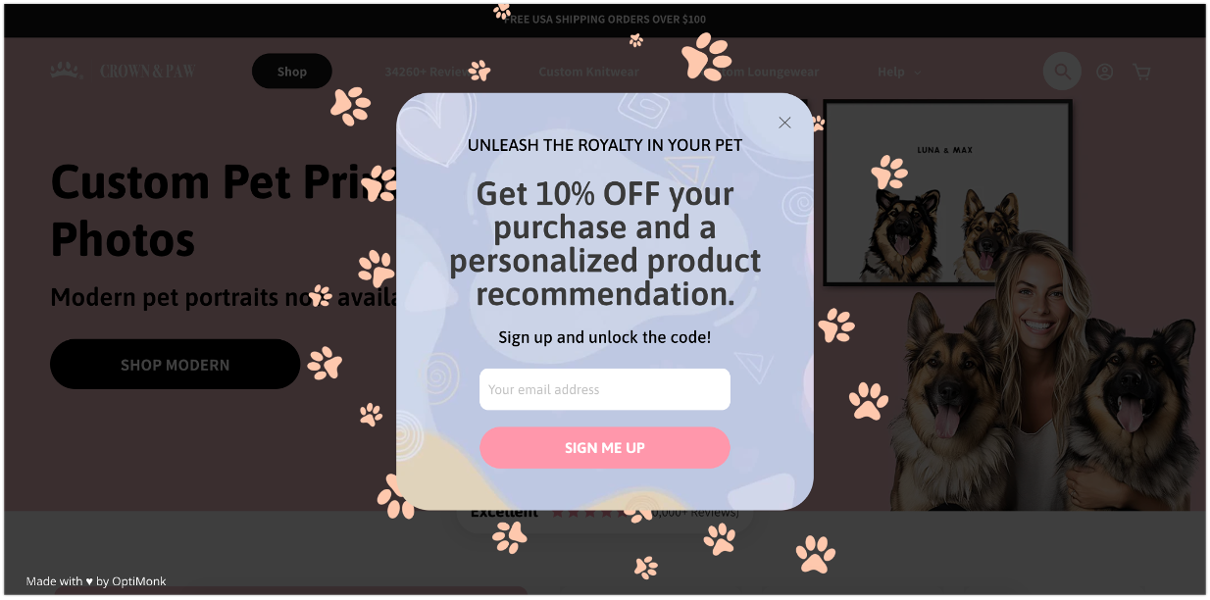
In the second step, once visitors had demonstrated that they wanted to grab that 10% off, they asked simple questions to learn about their interests.
Here are the questions they asked:
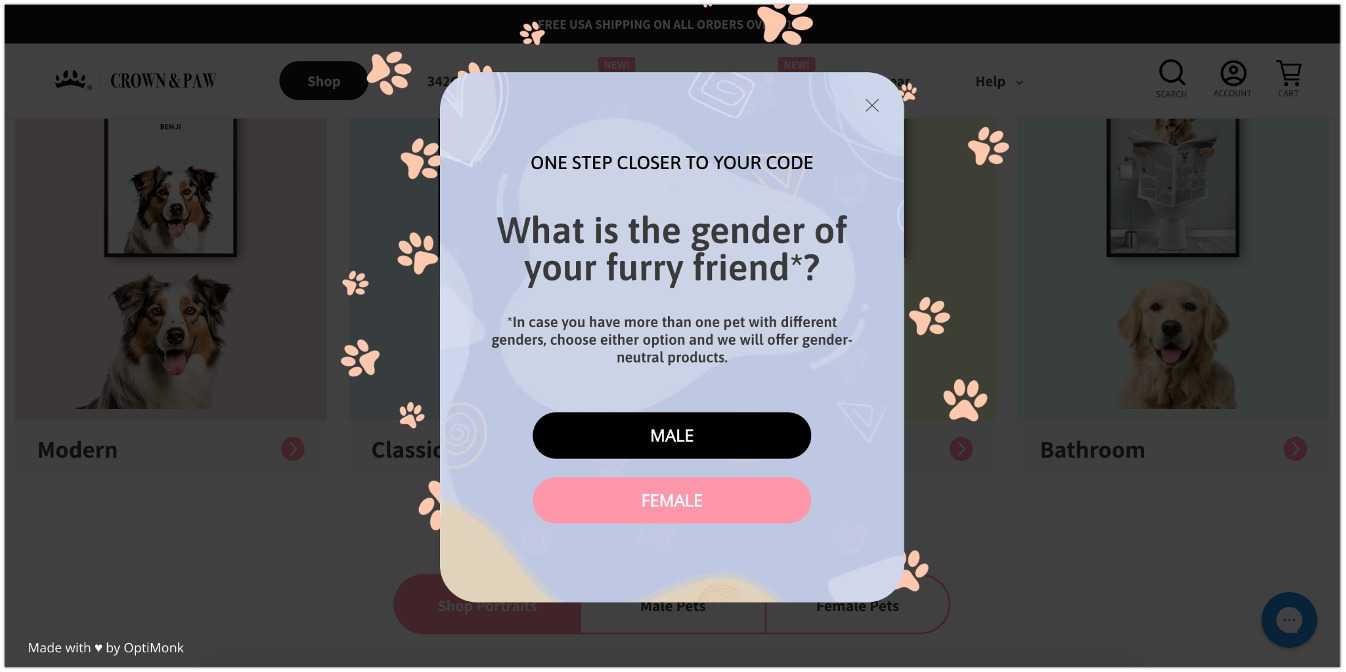
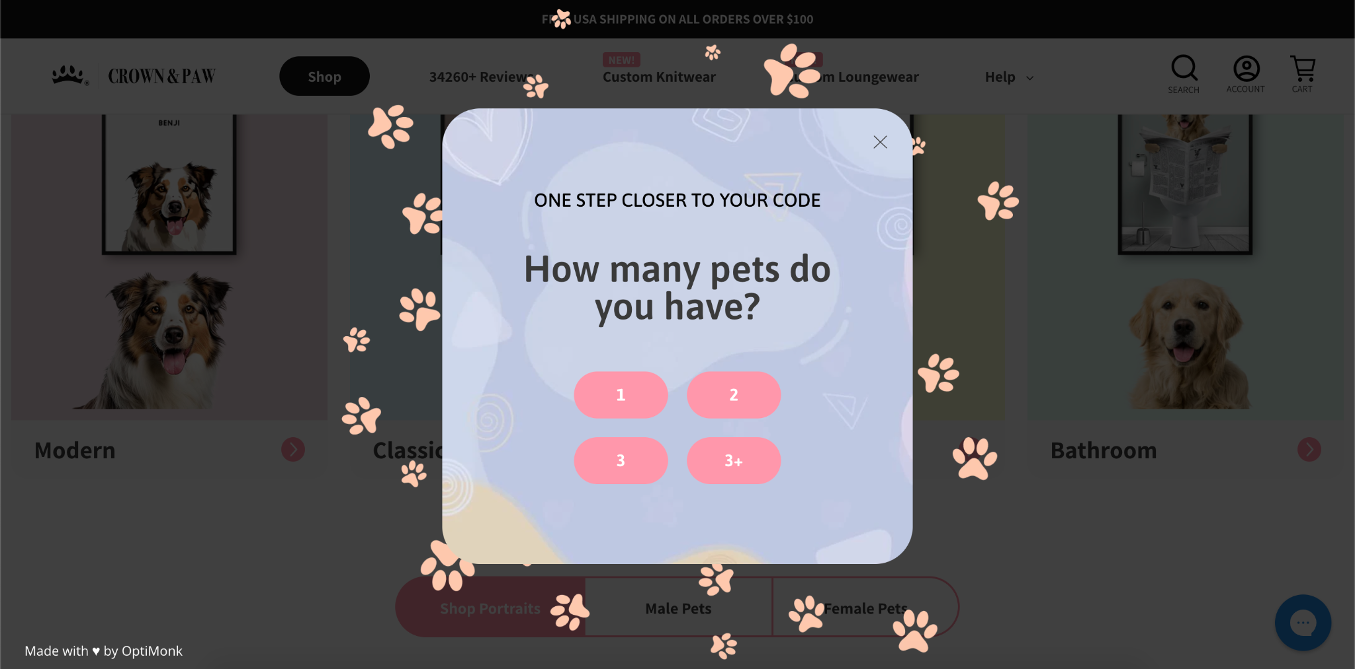
For the 95% who answered their questions, Crown & Paw revealed personalized product recommendations alongside the discount code in the final step.
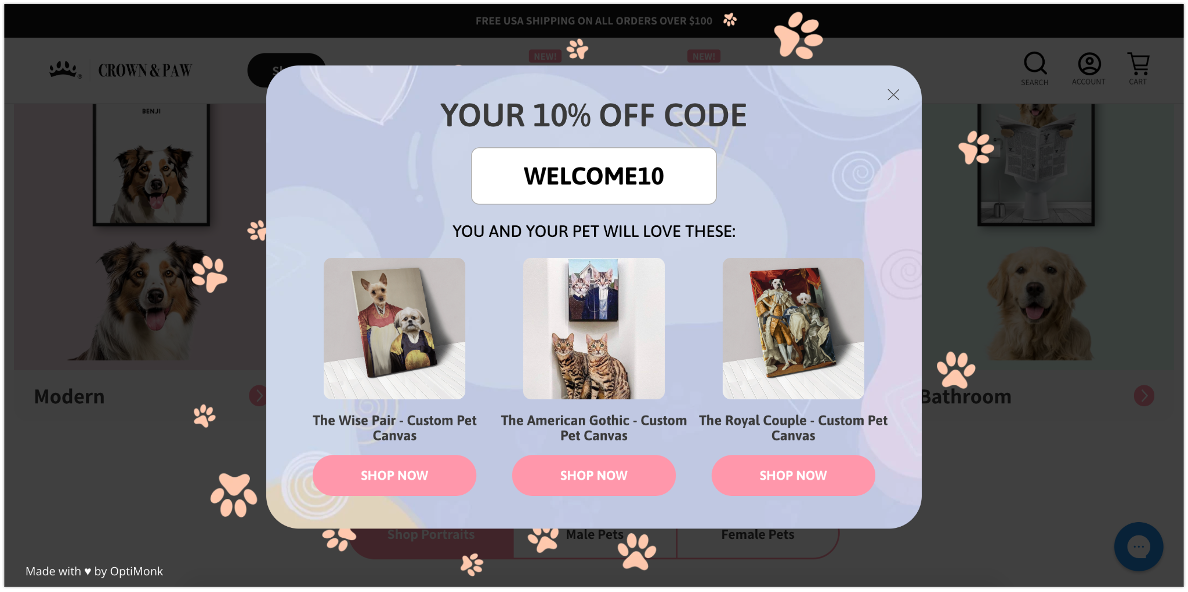
The result? A 4.03% conversion rate, and a massive 2.5X increase from their previous email popup strategy.
This is tangible proof that creatively engaging your audience can work wonders.
FAQ
What is an example of a market experiment?
An example of a marketing experiment could involve an e-commerce company testing the impact of offering free shipping on orders over $50 for a month. If they find that the promotion significantly increases total sales revenue and average order value, they may decide to implement the free shipping offer as a permanent strategy.
What is experimental data in marketing?
Experimental data in marketing refers to information collected through tests or experiments designed to investigate specific hypotheses. This data is obtained by running experiments and measuring outcomes to draw conclusions about marketing strategies.
How do you run a marketing experiment?
To run a marketing experiment, start by defining your objective and hypothesis. Then, create control and experimental groups, collect relevant data, analyze the results, and make decisions based on the findings. This iterative process helps refine marketing strategies for better performance.
What are some real-life examples of experiment marketing?
Real-life examples of marketing experiments include A/B testing email subject lines to determine which leads to higher open rates, testing different ad creatives to measure click-through rates, and experimenting with pricing strategies to see how they affect sales and customer behavior.
How to brainstorm and prioritize ideas for marketing experiments?
Start by considering your current objectives and priorities for the upcoming quarter or year. Reflect on your past marketing strategies to identify successful approaches and areas where performance was lacking. Analyze your historical data to gain insights into what has worked previously and what has not. This examination may reveal lingering uncertainties or gaps in your understanding of which strategies are most effective. Use this information to generate new ideas for future experiments aimed at improving performance. After generating a list of potential strategies, prioritize them based on factors such as relevance to your goals, timeliness of implementation, and expected return on investment.
Wrapping up
Experiment marketing is a powerful tool for businesses and marketers looking to optimize their marketing strategies and drive better results.
By designing, implementing, analyzing, and learning from marketing experiments, you can ensure that your marketing efforts are data-driven, focused on the most impactful tactics, and continuously improving.
Want to level up your marketing strategy with a bit of experimenting? Then give OptiMonk a try today by signing up for a free account!
Migration has never been easier
We made switching a no-brainer with our free, white-glove onboarding service so you can get started in the blink of an eye.
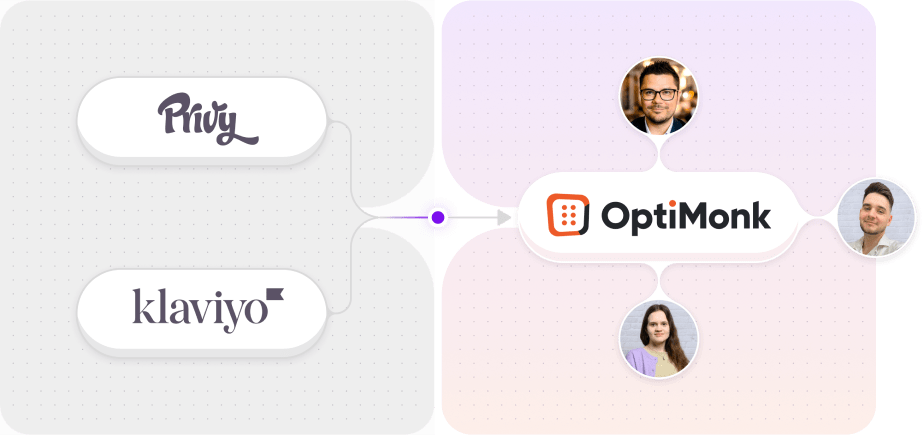
What should you do next?
Thanks for reading till the end. Here are 4 ways we can help you grow your business:
Boost conversions with proven use cases
Explore our Use Case Library, filled with actionable personalization examples and step-by-step guides to unlock your website's full potential. Check out Use Case Library
Create a free OptiMonk account
Create a free OptiMonk account and easily get started with popups and conversion rate optimization. Get OptiMonk free
Get advice from a CRO expert
Schedule a personalized discovery call with one of our experts to explore how OptiMonk can help you grow your business. Book a demo
Join our weekly newsletter
Real CRO insights & marketing tips. No fluff. Straight to your inbox. Subscribe now
Nikolett Lorincz
- Posted in
- Marketing
Partner with us
- © OptiMonk. All rights reserved!
- Terms of Use
- Privacy Policy
- Cookie Policy
Product updates: January Release 2025








